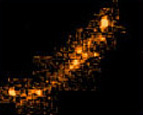An image of the discovered galaxy
Click on image for full size
NASA
A Long Time Ago in A Galaxy Far, Far Away...
News story originally written on August 1, 1997
A NASA Hubble Space Telescope image revealed the most distant galaxy found in the universe to date. The image the telescope took was of a galaxy cluster located 5 billion light years away. The discovered galaxy is located behind the galaxy cluster 13 billion years away.
The galaxy cluster is called a gravitational lens . It acted as a magnifying glass for scientists to look through. Looking through the galaxy cluster caused the discovered galaxy's image to be brighter and bigger than it would have appeared otherwise.
The newly discovered galaxy is very far away! Measurements show that it is the farthest galaxy ever seen at a distance of 13 billion light-years away. So the light that is reaching us now is actually 13 billion years old. That is how long the light took to travel to Earth.
So what we see occurring in the galaxy actually occurred 13 billion years ago, or a LONG time ago. Scientists hope that this will add to our knowledge of galaxy formation and stars within these galaxies.
The image was taken with Hubble's Wide Field Planetary Camera-2 on January 13, 1996. Many more exciting discoveries are expected from the orbiting telescope.
You might also be interested in:

It was another exciting and frustrating year for the space science program. It seemed that every step forward led to one backwards. Either way, NASA led the way to a great century of discovery. Unfortunately,
...more
The Space Shuttle Discovery lifted off from Kennedy Space Center on October 29th at 2:19 p.m. EST. The weather was great as Discovery took 8 1/2 minutes to reach orbit. This was the United States' 123rd
...more
A moon was discovered orbiting the asteroid, Eugenia. This is only the second time in history that a satellite has been seen circling an asteroid. A special mirror allowed scientists to find the moon
...more
Will Russia ever put the service module for the International Space Station in space? NASA officials want an answer from the Russian government. The necessary service module is currently waiting to be
...more
A coronal mass ejection (CME) happened on the Sun early last month. The material that was thrown out from this explosion passed the ACE spacecraft. The SWICS instrument on ACE has produced a new and very
...more
J.S. Maini of the Canadian Forest Service called forests the "heart and lungs of the world." This is because forests filter air and water pollution, absorb carbon dioxide, release oxygen, and maintain
...more
In late April through mid-May 2002, all five naked-eye planets are visible at the same time in the night sky! This is includes Mercury which is generally very hard to see. You won't want to miss this!
...more















